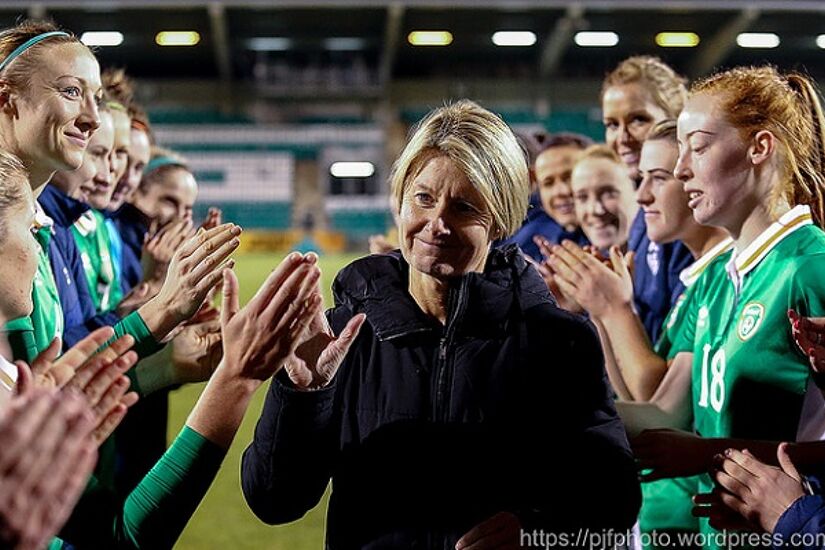Sue Ronan - 'It's frustrating that on sports shows or in sports pages there's nothing about women competing internationally'

Credit: Peter Fitzpatrick (ETPhotos)
22 Republic of Ireland caps, national team manager from 2010-2016 and current head of women’s football with the FAI, Sue Ronan has experienced diverse roles throughout her career in sport.
As a youth, Ronan turned out for Cherrywood and Packard before progressing to the senior ranks of Welsox and Shelbourne. The Dubliner made her international debut under Fran Rooney (later FAI CEO) away to Sweden in 1988, was converted from a striker to a midfielder by Mick Cooke, and went on to captain the women's national team.
“I came late into organised football," Ronan tells extratime.ie
"Not only was I unaware of the club structure in Ireland, but also of what was going on at national level women’s football worldwide. Once I started playing, I soon came in contact with girls in the national squad and heard about scholarships in the US.”
Content within the domestic scene, Sue picked up the 1993 Women’s Player of the Year award.
“It was a proud moment for me and my family. Particularly my dad, who I got my love of football from. I didn’t expect nomination, never mind win it, so it was a shock. My dad accompanied me to the function and our photo from the night still hangs proudly in our family home.”
Reflecting upon her playing days, Ronan points out major differences for the present domestic female footballer.
“Back then, the game was totally run by volunteers. Many of whom, still volunteer today. The LFAI (Ladies Football Association of Ireland) were affiliated to the FAI. They not only ran the leagues, but also the national squad, fundraising to finance its activities.
"There were no underage national sides until the mid-nineties. Leagues were mainly adult and ad hoc around the country. No specific programmes to encourage young girls into the game, nor elite ones for our best players. National players were expected to turn up fit and prepared.
"Nothing especially to develop or entice more female referees or coaches. Now, women’s football is under the FAI umbrella, with a women’s committee key and the chair on the FAI Board. We have a Women’s National League, with an under-17 version starting later this year, plus strong local leagues for both adults and girls, so opportunities for females, no matter where they live or their ability.”
Encouraged by Cooke into coaching in 1996, Sue worked her way to become Noel King’s successor as WNT manager in 2010.
“I’d come from being under-19s boss for the previous decade, but was also Mick’s assistant with the under-18s in the late nineties and manager of the under-16s, so nearly every WNT footballer had played for me underage. Seeing them become senior international players was very satisfying.”
Based on Ronan’s overall experience within the women’s game, the transition to her current administrative position in 2016 came as no surprise.
“Since I started working full-time in football in 2006, it was an area I was involved in, even while coaching. When I managed the under-19s and WNT, I was part-time, with the other half of my role on the development side of women’s football, so it wasn’t huge for me going full-time into that side of the game.
"However, I miss coaching. I didn’t realise how much, so it’s definitely something I would like to get back into at some point. Hopefully, my pro licence will provide opportunities to work with elite players in the future, whether that be women or men.”
As one of the few Irish females to hold an Elite UEFA Pro Licence, the Crumlin native shares why she believes there aren’t more.
“One of the biggest problems encouraging women to the top end of the coach education ladder is the lack of opportunities. To get to that level takes a lot of time and money. Most male coaches working in women’s football could enter the men’s game, whereas the reverse is mainly not the case and that’s a problem.”
Under Sue’s tenure, women’s football has witnessed positive implementations, with more to come.
“When I came into my current role, the governance structure had just changed. Previously, all club and league activity, with the exception of the Women’s National League, was run by the WFAI. The new one saw the WFAI integrate into the FAI’s structures, a WFC (Women’s Football Committee) formed at national level to oversee the game’s development and the country divided into eight regions, with a regional committee responsible for their respective areas.
"The chair of those committees sit on the WFC and their remit is to grow the game regionally, based on their needs and national level targets. A big part of my role is to link in with the aforementioned committees to set priorities for growth.
"Two years in, while some great work has been done nationwide, there’s still a way to go. Our current Women’s Strategic Plan finishes this year and we’re reviewing achievements in each area of the game and the gaps, with a view to writing a new one. This should provide a women’s football blueprint in Ireland over the next four/five years.”
Ronan concludes by lamenting a lack of domestic media coverage for women’s football at all levels.
“It’s been problematic across all women’s sport, although it has improved in recent times. Up until lately, female athletes had to be successful to get consistent press coverage, even those competing at national level, while even less attention’s paid to domestic activity - in soccer, anyway!
"In the mid-noughties, Katie Taylor was in my under-19 squad, was the European and World Boxing Champion, but still got miniscule coverage. Female sports should get the same exposure as their male counterparts … We’re not asking for anything different or more.
"It’s frustrating that on sports shows or in sports pages there’s nothing about women competing internationally, yet most domestic male sports are covered. There’s no excuse and won’t encourage young girls into sport.”

